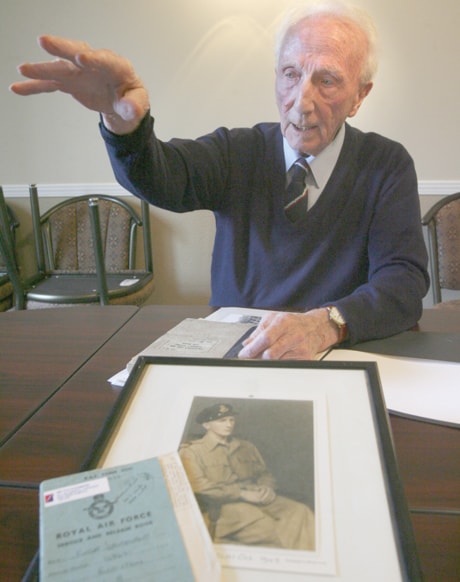The Second World War was close to its end when Red Deer veteran Leslie “Doc” Euinton met an unexpected adversary.
“Our enemy by that time was the weather,” Euinton said. “It was monsoon season.”
Euinton was sent to co-pilot planes with the Royal Air Force 117 Squadron in Burma — now Myanmar — in 1944. He said by the time they arrived in Burma, the Japanese troops had largely been defeated.
Euinton remembers co-piloting a Dakota one day and warning the pilot that they were nearing cumulonimbus clouds. The clouds are tall and dense and can form into thunderstorms and supercells.
But the pilot wanted to have a look and soon the plane was out of control, the dials were spinning and the plane did a turn and then a roll. Euinton had to take control and managed to land the Dakota.
“When we got it back, you could actually see wrinkles on the back of the plane and the wings were pushed up and the whole plane was written off even though we managed to get it back,” Euinton said. The wrinkles were so extreme on the plane that it looked like someone had folded it like an accordion. The pilot never flew again but Euinton continued.
He flew 68 operations in Burma, dropping supplies to Allied troops on the ground. He still has his log book, with each flight noted in precise print.
The Dakotas they flew were stripped of everything so that they could carry as many supplies as possible. As a result, there were no doors or oxygen tanks on the planes. As they had to fly up to 11,000 feet, Euinton said the co-pilot and pilot would hope that at least one of them wouldn’t pass out.
While many of the Japanese troops had been defeated, there were still troops around and if they flew close to the mountain ranges, they would experience small arms firing at them.
The Second World War started before Euinton — who grew up in London, England — was even out of his teens. His family had to move three times around London after being bombed out. Euinton registered for the service at age 20 in November 1940 in London. Now nearly 90 years old, he vividly remembers his time in the air force.
Because he was in one of the reserved occupations as an engineering draftsman, he wasn’t immediately called into service.
Finally in April 1942, he joined up. Euinton was first sent to flying training school in Scotland and then to South Africa for training. He came out at the top of his class in the air school and was asked to stay on as an instructor, but opted to be commissioned right away. He spent time in Ringway in Greater Manchester working with the parachutists. He shared a hut with seven others and there was a girl who came in to clean up. She became Snow White and the bunk mates were the seven dwarfs, with Euinton gaining his nickname “Doc.” He never saw anyone so distraught as when the girl learned three of her dwarfs — Grumpy, Sneezy and Dopey — had all been killed while flying with a new pilot.
After the war ended, Euinton was given the acting rank of squadron leader and did a staff tour, travelling to Delhi, Karachi, Bombay, Bangalore, Madras and many places in between, trying to get all of the airline pilots to convert to airline standards and documentation. Then he applied to go to medical school at Leeds, getting chosen for one of the 80 spots from the 2,000 applications. He was eventually hired as one of Her Majesty’s Medical Inspector of Factories, overseeing working standards in 25,000 factories around the United Kingdom. He was particularly concerned about mercury poisoning and noise standards.
In 1974, he was hired as the director of health and safety in Saskatchewan and wrote the first Occupational Health and Safety Act for Saskatchewan, which was later copied by Manitoba. He also worked with the Jimmy Carter administration before heading back to the U.K.
All but one of his children remained in Canada, but Euinton and his wife Joy returned to England in the early 1980s, staying there 20 years. They returned to Canada in 2004 and now live in Red Deer.
Euinton was one of close to 2,000 veterans who have shared their stories with the Memory Project: Stories of the Second World War, an initiative of the Historica-Dominion Institute. The project is funded through the Department of Canadian Heritage and started in 2009. People can listen to more than 1,100 interviews with Second World War veterans on the project’s website at www.thememoryproject.com
The Memory Project will continue to interview Second World War veterans until at least until March 2011. Veterans can phone toll-free 1-866-701-1867 to share their stories.
Project manager Jenna Misener said she would like to see it eventually expand to include those who served during the Korean War, on peacekeeping missions and in Afghanistan, but it will depend on funding.
“We want to ensure that generations to come can hear those first-hand accounts and really experience the stories of these veterans and the things that they went through and ultimately their service and sacrifice for this country,” Misener said. “Textbooks have their place in classrooms, but there is nothing like hearing first-hand from a veteran what it was like to be in combat or to enlist and go off to war when they weren’t that much older than the students are today.”
sobrien@www.reddeeradvocate.com
